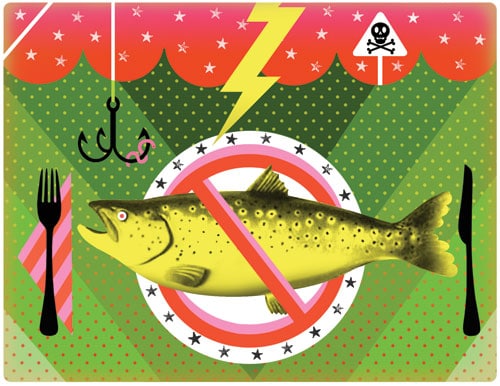
Fishy Source
Q: Is it safe to eat fish from Indiana waterways? Some of them are pretty nasty.
Julia S., Fishers
A: It depends on where you fish, what you catch, and how often you eat it. According to the state’s unappetizing Fish Consumption Advisory, there’s a long list of heavily contaminated Indiana waterways from which no aquatic life should ever be eaten. So if you happen to haul in a big one while fishing at, say, Stony Creek in Hamilton County, Pleasant Run Creek in Lawrence County, or (duh) the Grand Calumet River in Lake County, throw it back. Then go wash your hands.
Children, along with women who are pregnant or of childbearing age, also shouldn’t make a habit of gorging themselves at local fish fries. Indiana fish can pick up a long list of contaminants, including (but by no means confined to) PCBs, pesticides, and mercury. Even kids and mommy types dining on lightly contaminated, relatively benign “Level 1” critters should limit consumption to just one 2-ounce or 8-ounce filet (respectively) per week. And pretty much everybody, everywhere, should steer clear of carp. These bottom-feeders can accumulate huge loads of toxins in their bodies. Plus, they’re gross.
And speaking of gross stuff, the guide also documents the contamination levels of the creek chub, hornyhead chub, white sucker, and northern hogsucker—even though they’re all nasty little “junk fish” that no one outside of a starving Neolithic hunter-gatherer would consider consuming. Still, The Hoosierist appreciates their inclusion because it gives him an excuse to mention the hilariously named hornyhead chub once—and now twice—in print.
Q: How does the state decide which organizations deserve their own specialty license plates?
Alex B., Carmel
A: It happens pretty much the same way any other grassroots effort gets done: Somebody goes around with a clipboard, gathering signatures. According to the Bureau of Motor Vehicles, organizations must be not-for-profits serving the entire state, and they must produce the John Hancocks of at least 500 people committed to purchasing the group’s BMV plate. Those tags cost $40 each (in addition to the usual fees), with $25 of that going to the sponsoring organization.
The idea seems to be a big hit with not-for-profits, given that 99 of them—10 new ones this year alone—have signed on to offer specialty plates. So if you want to show your support for, say, the Indiana Patriot Guard Riders, the Lions of Indiana, or the International Union of Operating Engineers, all you have to do is order their tags and get in line.
Q: During a recent trip to Brown County, I realized there seem to be a lot more places in Indiana where people aren’t than are. If I really wanted to get away from it all, what’s the least-populated corner of the state?
Helen O., Indianapolis
A: The Hoosierist wonders why you need to get out of Dodge so badly. But being a nonjudgmental sort, he’ll nevertheless of-fer his opinion on the best place in Indiana to avoid being seen. While Brown County’s population of roughly 15,000 is indeedminiscule, it’s Tokyo compared to the almost entirely deserted Ohio County. Located on the state’s southeastern frontier, this 87-square-mile flyspeck is both the state’s smallest county and, with a population of about 6,000, its emptiest. To put that last number in perspective, if all of its residents decided to attend an Indians game at Victory Field, they wouldn’t fill half of its 15,500 seats.
Still, there are worse places for a desperate fugitive such as yourself to hole up. Like Monaco, another tiny principality surrounded by larger neighbors, Ohio County boasts lots of waterfront property (not the sunny Mediterranean, but the barge-filled Ohio River) and local gambling in the form of the Rising Star Casino Resort. You won’t find many James Bond types sipping vodka martinis and asking the punto banco dealer to “pass the shoe,” but the slots are pretty loose and the chicken wings fair. The perfect spot to lie low until the heat’s off back home.
Q: You always hear about tornado-chasers in places like Oklahoma and Nebraska, but rarely in Indiana. Why not here? Aren’t our twisters good enough?
Susan K., Bloomington
A: Actually, ours are a little too good—if by “good” you mean dangerously unpredictable. Storm-chasers stalk the Great Plains because tornados out there tend to be bigger, longer-lived, slower, and easier to spot. Plus the plains are, well, plain. You can chase a storm for miles over lightly traveled roads with nary a tree or building to obstruct the view.
Things get trickier in these parts, where hills, forests, and Indiana’s oddball weather conspire to complicate pursuits. Local meteorological conditions tend to produce groups of twisters rather than singletons, many of which coalesce and then dissipate in the blink of an eye. Which means that in theory, a tornado-chaser watching a storm in front of him could get bushwhacked by another that forms behind him. That’s the bad news. The good news is … well, there isn’t any. Just more bad. Hoosier tornados often come sheathed in torrential rain, making them very difficult to spot. And they’re freakishly fast. “We had a tornado not far from campus, back in October 2010, that was moving 70 miles per hour,” says Tony Lyza, director of the Valparaiso University Storm Intercept Team.
No wonder Lyza and his buddies from Valpo’s department of meteorology do much of their serious storm-chasing out West. Those tornados may be big, but at least they’re easy to spot. And they don’t move faster than The Hoosierist’s car.
>> Have a question about anything Indiana-related? Send it to hoosierist@indymonthly.emmis.com.
Illustration by Shane Harrison.
This article originally appeared in the April 2012 issue.





